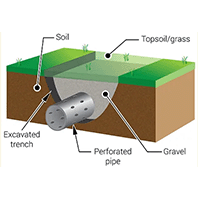
UNDERGROUND DRAINAGE


With the Greater Cincinnati and Northern Kentucky region receiving a moderate amount of rainfall with some storms being significant, a heavy rain can lead to drainage issues. If you have puddles in your yard when it rains, water is getting into your basement, you're noticing an increase in your water bills, you've noticed new cracks in your home's foundation or you've noticed mildew or mold in your basement, you may have a drainage issue, especially if you have a well functioning roof and gutter system and you’re experiencing any of these issues. If this is the case, you should consider an underground drainage solution to correct the issue.
Our technician can assess the issue you're experiencing and recommend the best underground draining solution for your home. If you have a solution in place that’s not functioning properly, we can also repair an existing drainage system. No matter the issue, we’re confident that we have a great solution to solve any underground drainage issue you’re having and prevent any future damage to your home.
French Drain
A French Drain is a pipe that collects and directs water away from the home with a wide, perforated pipe placed in the ground to collect excess water and drain it away from the affected area. The pipe is covered with rock or gravel, so it's not visible and it's drained downward to so that drainage is smooth. French Drains are often used when homeowners have issues with rain water sitting in their yard or around the home. A French Drain can be installed to collect the water and take it to a location where it no longer poses a threat.
Catch Basin
A catch basin is, in other words, a storm drain. They're used to redirect water in an aim to prevent flooding and are common on public streets but may also be installed on private properties. Catch basins collect rainwater or melted snow, transporting runoff to a sump, reservoir, or treatment facility.
Trenching
Trenching is a construction method that involves digging a narrow trench in the ground for the installation, maintenance, or inspection of pipelines, conduits, utility lines or cables.
Downspout / Downpipe Lines
Downspout Lines provide a safe place for rainwater to run off to, away from your homes foundation. They work with the Gutter System to collect rainwater and funnel it away from the homes foundation, typically through underground pipes that often direct the water to a storm drain system or the street. A downspout can also be installed to connect to a rain water barrel, as well.
Channel Drain
A Channel Drain is a linear system that incorporates a channel together with an inlet detail that is embedded in the constructed surface. It is used to take surface water away from an area to drain away and are typically installed in driveways and patios.
Dry Well
A dry well is a passive structure. Water flows through it under the influence of gravity. A dry well receives water from one or more entry pipes or channels at its top and discharges the same water through a number of small exit openings distributed over a larger surface area in the side(s) and bottom of the dry well.
Storm Drains
Storm drains are meant to collect rain water as well as the runoff from roofs and landscaping. If a storm drain becomes clogged with leaves or debris, excess water can flood the property.












